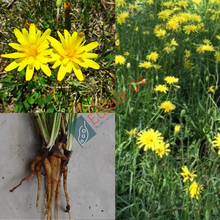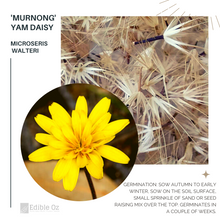Yam Daisy - Microseris walteri (Murnong) seeds
Regular price
$3.95
Sale
or make 4 interest-free payments of
$0.98 fortnightly with
 More info
More info
Microseris walteri - Yam Daisy (Murnong)
A culturally significant Australian perennial herb with edible tubers and bright yellow flowers, perfect for bush food gardens.
Quick Facts
- Height & Spread: Forms a tufted rosette of toothed lanceolate leaves, producing a single yellow flower per stem.
- Flowers: Bright yellow, dandelion-like blooms appearing in mid-summer to autumn.
- Fruits: Tubers develop mid-summer and are ready for harvest in autumn.
- Soil: Thrives in most soil types, preferring well-drained conditions.
- Position: Grows well in full sun to part shade.
- Climate: Drought- and frost-tolerant, adaptable to various conditions.
Why Grow Microseris walteri?
Murnong is a fast-growing and versatile plant with rich cultural significance. Its sweet tubers and edible leaves are perfect for bush food cultivation, while its striking yellow flowers bring visual interest to native gardens and landscapes.
Bush Food Note
Murnong tubers were a staple food for the Wurundjeri people and are deliciously versatile:
- Taste: Sweet with a flavor similar to coconut.
- Uses:
- Tubers can be eaten raw, roasted, or pit-baked.
- Incorporated into salads, mixed with vegetables, or turned into a paste for desserts.
- Slightly bitter leaves are also edible and can be used in salads or as cooked greens.
How to Grow
Sowing Instructions:
- Sow seeds in autumn to early winter; hot weather inhibits germination.
- Sprinkle seeds on the soil surface and lightly cover with sand or seed-raising mix to prevent displacement.
Position:
- Plant in full sun to part shade for optimal growth.
- Suitable for a range of soil types but ensure good drainage.
Care Tips:
- Water regularly during establishment; drought-tolerant once mature.
- Harvest tubers in autumn when the plant flowers.
- Protect from grazing animals to maintain healthy plants.
Uses in Your Garden
- Bush Food Garden: Produces sweet, edible tubers and leaves for traditional and modern recipes.
- Ornamental Value: Bright yellow flowers add charm to gardens and landscapes.
- Wildlife Habitat: Attracts pollinators and supports local biodiversity.
- Erosion Control: Dense growth stabilizes soil in degraded areas.
Germination Tips
- Timeframe: Seeds germinate within 1–2 weeks under optimal conditions.
- Season: Sow seeds in autumn to early winter.
- Light: Surface-sown seeds benefit from light exposure.
- Moisture: Keep soil consistently moist but not waterlogged during germination.
Order Now
Grow a piece of Australia’s cultural and botanical heritage with Microseris walteri. Its delicious tubers, edible leaves, and vibrant flowers make it a standout addition to any bush food or native garden.
Order your Yam Daisy seeds today and support the revival of this traditional staple food!



